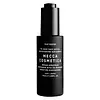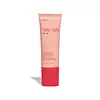What's inside
What's inside
 Key Ingredients
Key Ingredients

 Benefits
Benefits

 Concerns
Concerns

 Ingredients Side-by-side
Ingredients Side-by-side

Bis-Ethylhexyloxyphenol Methoxyphenyl Triazine
Skin ConditioningButyl Methoxydibenzoylmethane
UV AbsorberEthylhexyl Triazone
UV AbsorberHomosalate
Skin ConditioningMethylene Bis-Benzotriazolyl Tetramethylbutylphenol
UV FilterOctocrylene
UV Absorber1,2-Hexanediol
Skin ConditioningButylene Glycol
HumectantAcrylates Copolymer
C12-15 Alkyl Benzoate
AntimicrobialCaprylyl Glycol
EmollientCaramel
Cosmetic ColorantCitric Acid
BufferingDecyl Glucoside
CleansingDecylene Glycol
Skin ConditioningDibutyl Adipate
EmollientDisodium EDTA
Tocopheryl Acetate
AntioxidantParfum
MaskingGlyceryl Hydroxystearate
EmollientDipotassium Glycyrrhizate
HumectantMica
Cosmetic ColorantNiacinamide
SmoothingPhenoxyethanol
PreservativePolyglyceryl-3 Methylglucose Distearate
EmulsifyingPonceau Sx
Potassium Cetyl Phosphate
EmulsifyingPropylene Glycol
HumectantWater
Skin ConditioningSaccharide Isomerate
HumectantSodium Citrate
BufferingCI 15985
Cosmetic ColorantTitanium Dioxide
Cosmetic ColorantTriethanolamine
BufferingXanthan Gum
EmulsifyingBis-Ethylhexyloxyphenol Methoxyphenyl Triazine, Butyl Methoxydibenzoylmethane, Ethylhexyl Triazone, Homosalate, Methylene Bis-Benzotriazolyl Tetramethylbutylphenol, Octocrylene, 1,2-Hexanediol, Butylene Glycol, Acrylates Copolymer, C12-15 Alkyl Benzoate, Caprylyl Glycol, Caramel, Citric Acid, Decyl Glucoside, Decylene Glycol, Dibutyl Adipate, Disodium EDTA, Tocopheryl Acetate, Parfum, Glyceryl Hydroxystearate, Dipotassium Glycyrrhizate, Mica, Niacinamide, Phenoxyethanol, Polyglyceryl-3 Methylglucose Distearate, Ponceau Sx, Potassium Cetyl Phosphate, Propylene Glycol, Water, Saccharide Isomerate, Sodium Citrate, CI 15985, Titanium Dioxide, Triethanolamine, Xanthan Gum
Water
Skin ConditioningDicaprylyl Carbonate
EmollientDiethylamino Hydroxybenzoyl Hexyl Benzoate
UV FilterEthylhexyl Triazone
UV AbsorberPotassium Cetyl Phosphate
EmulsifyingGlyceryl Stearate
EmollientBis-Ethylhexyloxyphenol Methoxyphenyl Triazine
Skin ConditioningGlycerin
HumectantCetearyl Alcohol
EmollientTris-Biphenyl Triazine
UV AbsorberTapioca Starch
Propanediol
SolventAloe Barbadensis Leaf Juice
Skin ConditioningTocopherol
AntioxidantUbiquinone
AntioxidantGlycine Soja Oil
EmollientTerminalia Ferdinandiana Fruit Extract
AntioxidantJojoba Esters
EmollientXanthan Gum
EmulsifyingOctyldodecanol
EmollientButylene Glycol
HumectantTrihydroxystearin
Skin ConditioningDecyl Glucoside
CleansingGlyceryl Caprylate
EmollientBenzyl Alcohol
PerfumingCaprylhydroxamic Acid
Salicylic Acid
MaskingDisodium Phosphate
BufferingSorbic Acid
PreservativeSodium Dehydroacetate
PreservativePotassium Hydroxide
BufferingIron Oxides
Parfum
MaskingWater, Dicaprylyl Carbonate, Diethylamino Hydroxybenzoyl Hexyl Benzoate, Ethylhexyl Triazone, Potassium Cetyl Phosphate, Glyceryl Stearate, Bis-Ethylhexyloxyphenol Methoxyphenyl Triazine, Glycerin, Cetearyl Alcohol, Tris-Biphenyl Triazine, Tapioca Starch, Propanediol, Aloe Barbadensis Leaf Juice, Tocopherol, Ubiquinone, Glycine Soja Oil, Terminalia Ferdinandiana Fruit Extract, Jojoba Esters, Xanthan Gum, Octyldodecanol, Butylene Glycol, Trihydroxystearin, Decyl Glucoside, Glyceryl Caprylate, Benzyl Alcohol, Caprylhydroxamic Acid, Salicylic Acid, Disodium Phosphate, Sorbic Acid, Sodium Dehydroacetate, Potassium Hydroxide, Iron Oxides, Parfum
 Reviews
Reviews

Ingredients Explained
These ingredients are found in both products.
Ingredients higher up in an ingredient list are typically present in a larger amount.
You might know this ingredient as Tinosorb S or Bemotrizinol. It is a UV filter that covers both UVA and UVB rays.
This ingredient has two peak UV absorption peaks ( 310 and 340 nm) and is able to absorb both UV-A and UV-B rays. This ingredient works by preventing UV rays from reaching and damaging your skin.
On top of that - it is highly photostable and helps prevent the photodegration of other sunscreen ingredients such as avobenzone.
Tinosorb S is allowed in the EU, Australia, and Asia. It is close to being approved by the FDA and we'll hopefully get this ingredient in the U.S. by late 2025.
Fun fact: Tinosorb S is the most effective UV absorber at maximum concentration (measured by SPF) permitted in the EU.
This ingredient is oil-soluble, so your oil-cleansers will take this right off at night.
Learn more about Bis-Ethylhexyloxyphenol Methoxyphenyl TriazineButylene Glycol (or BG) is used within cosmetic products for a few different reasons:
Overall, Butylene Glycol is a safe and well-rounded ingredient that works well with other ingredients.
Though this ingredient works well with most skin types, some people with sensitive skin may experience a reaction such as allergic rashes, closed comedones, or itchiness.
Learn more about Butylene GlycolDecyl Glucoside is a glucose-based surfactant and emulsion stabilizer. It is created by reacting glucose with the fatty acids from plants.
Surfactants help clean the skin by trapping oil, sebum, and dirt to be washed away. As an emulsion stabilizer, it stabilizes the ingredients in a product by preventing them from separating.
This ingredient is biodegradable and non-toxic. This ingredient is commonly found in baby shampoos.
Decyl Glucoside is sometimes used to stabilize the UV filter Tinosorb.
Learn more about Decyl GlucosideEthylhexyl Triazone is a modern chemical sunscreen that protects from UV-B radiation.
It is the most effective of existing UV-B filters, as it provides the highest level of photo-stable absorption. It protects from the entire UV-B range (280 to 320nm), with it's highest level of protection at 314nm.
Ethylhexyl Triazone is oil soluble, oderless and colorless, which mean it is able to be incorporated into a variety of different formulations.
It is not currently available within the United States due to slow changing FDA regulations. Outside of the US, it is used in formulations at concentrations up to 5%.
Learn more about Ethylhexyl TriazoneParfum is a catch-all term for an ingredient or more that is used to give a scent to products.
Also called "fragrance", this ingredient can be a blend of hundreds of chemicals or plant oils. This means every product with "fragrance" or "parfum" in the ingredients list is a different mixture.
For instance, Habanolide is a proprietary trade name for a specific aroma chemical. When used as a fragrance ingredient in cosmetics, most aroma chemicals fall under the broad labeling category of “FRAGRANCE” or “PARFUM” according to EU and US regulations.
The term 'parfum' or 'fragrance' is not regulated in many countries. In many cases, it is up to the brand to define this term.
For instance, many brands choose to label themselves as "fragrance-free" because they are not using synthetic fragrances. However, their products may still contain ingredients such as essential oils that are considered a fragrance by INCI standards.
One example is Calendula flower extract. Calendula is an essential oil that still imparts a scent or 'fragrance'.
Depending on the blend, the ingredients in the mixture can cause allergies and sensitivities on the skin. Some ingredients that are known EU allergens include linalool and citronellol.
Parfum can also be used to mask or cover an unpleasant scent.
The bottom line is: not all fragrances/parfum/ingredients are created equally. If you are worried about fragrances, we recommend taking a closer look at an ingredient. And of course, we always recommend speaking with a professional.
Learn more about ParfumPotassium Cetyl Phosphate is the potassium salt of a mixture. This mixture consists of the esters from phosphoricacid and cetyl alcohol.
Potassium Cetyl Phosphate is an emulsifier and cleansing agent. Emulsifiers help stabilize a product. It does this by preventing certain ingredients from separating.
As a cleansing agent, Potassium Cetyl Phosphate helps gather oils, dirts, and pollutants from your skin. This makes it easier to rinse them away with water.
Learn more about Potassium Cetyl PhosphateWater. It's the most common cosmetic ingredient of all. You'll usually see it at the top of ingredient lists, meaning that it makes up the largest part of the product.
So why is it so popular? Water most often acts as a solvent - this means that it helps dissolve other ingredients into the formulation.
You'll also recognize water as that liquid we all need to stay alive. If you see this, drink a glass of water. Stay hydrated!
Learn more about WaterXanthan gum is used as a stabilizer and thickener within cosmetic products. It helps give products a sticky, thick feeling - preventing them from being too runny.
On the technical side of things, xanthan gum is a polysaccharide - a combination consisting of multiple sugar molecules bonded together.
Xanthan gum is a pretty common and great ingredient. It is a natural, non-toxic, non-irritating ingredient that is also commonly used in food products.
Learn more about Xanthan Gum